 |
Focus features two in-depth reviews each month of fine art, architecture and design exhibitions and events at art museums, galleries and alternative spaces around Japan. The contributors are non-Japanese art critics living in Japan. |
|
|
 |
 |
 |
The Masterworks of Fumio Asakura
Nicolai Kruger |
 |
On a cold but bright blue Saturday afternoon I ventured into one of the many gems of Taito-ku, Tokyo. Hugging the slope west of JR Nippori station with Yanaka and its historical cemetery, the Asakura Choso Museum fits snugly into its context of two-story traditional houses, temples and craft shops. An architectural masterwork created by sculptor Fumio Asakura (1883-1964), the museum combines a modernist ferroconcrete structure, which was used by the artist as his atelier, with a wood and bamboo traditional sukiya-style home where he lived. These two structures wrap around a springwater-supplied courtyard garden. Above the atelier is a stunning, western-style roof garden.
|
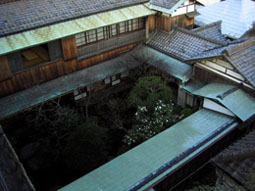 |
 |
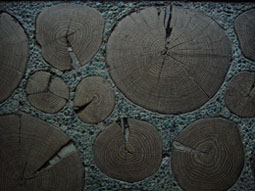 |
| Looking down into the courtyard "Goten no Suitei" |
 |
An innovative floor detail in the museum's foyer |
|
|
|
The main studio is an impressive interior space with caramel-colored walls and a ceiling height of nearly nine meters, perfectly appointed to display Asakura's grandes oeuvres in bronze. Two pieces that anchor the exhibit are "Flowing Time" (1917, a then-scandalous female nude relegated by police to a special viewing room at the Tokyo Arts University) and "Sir Shigenobu Okuma" (1932, a larger-than-life sculpture of the former Japanese prime minister and founder of Waseda University). General fluorescent lighting does not elevate the works or provide appropriate contrast for viewing sculpture. The garden views and use of daylighting, however, offer an ambience and sense of discovery around every corner.
 |
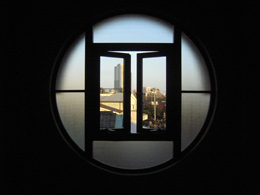 |
 |
Through the round window on the second floor, we can see the context changing. |
|
|
The man often referred to as the Father of Modern Japanese Sculpture was a prolific creator of naturalistic realism. He attended and then taught at Tokyo Bijutsu Gakko (now Gei-Dai, the Tokyo National University of Fine Arts and Music). I couldn't help but think that the creator of this work may have studied in Europe. In fact he did not. Judging by the volumes in his beautifully proportioned library, however, he held his European contemporaries (such as Auguste Rodin) in high esteem.
|
|
Aside from the female nudes and occasional diplomat, Asakura's list of muses also includes 15 stray cats that he cared for. They have earned a room on the upper level, a showcase for his uncompromising observation of nature. The cat exhibit is followed by a sequence of spaces that were originally used for artistic cultural interactions, now for a twice-yearly lecture series. A long band of windows allows views onto the courtyard. The atelier, gardens and residence have recently been registered as architecturally significant and scenic monuments by the Ministry of Education, Culture, Sports, Science & Technology (MEXT).
|
 |
|
A quick sketch of the once-scandalous "Flowing Time" (1917) |
|
|
As I wandered around this creaky complex, I became frustrated by numerous signs reading "Do Not Enter." I learned that in September last year, the garden and the bamboo structure were deemed seismically unsuitable for public access. These spaces are now off-limits pending necessary repairs.
Compared to other publicly owned museums dedicated to master sculptors of the same era, such as the Museé Le Rodin in Paris and the Vigeland Sculpture Park in Oslo, the museum dedicated to Asakura in Taito-ku is underwhelming. Whereas the works by Asakura are certainly on par with his European counterparts, the venue has sadly fallen into disrepair -- Taito-ku is responsible for the stewardship of this cultural heritage site. Seeing Asakura's masterworks is an experience that will inspire those who are in need of an artistic awakening. But the Father of Modern Japanese Sculpture is still waiting for the recognition he deserves.
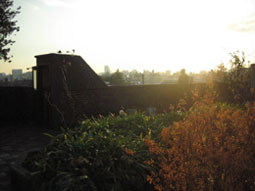 |
 |
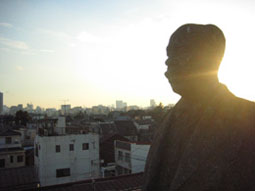 |
| The western-style roof garden in late afternoon |
 |
Asakura's pieces on the roof garden provide a contrast to the city beyond. |
|
| All photos and sketch by Nicolai Kruger |
 |
 |
 |
Nicolai Kruger
Nicolai Kruger is currently practicing architectural design and managing international projects at Pelli Clarke Pelli Architects, Japan. She has been living in Tokyo since 2006. She received her BFA in Design at Cornish College of the Arts in Seattle, followed by her Masters in Architecture at the University of Oregon. Her principal interests are temporary structures, mixed-use, exhibition spaces, and lighting design. |
|
 |
|